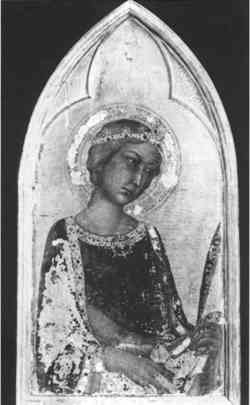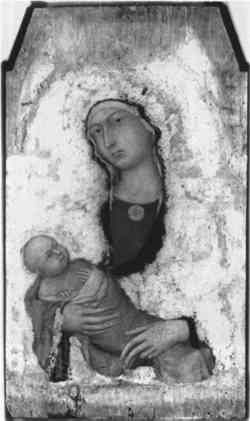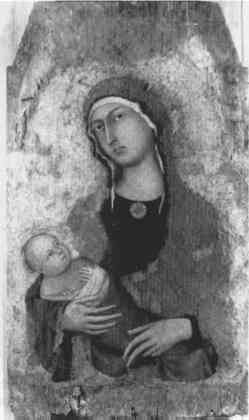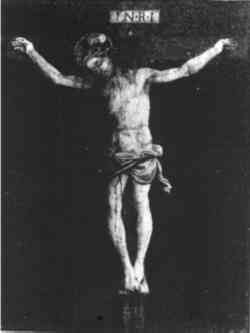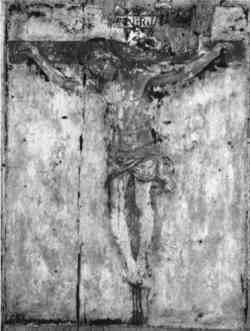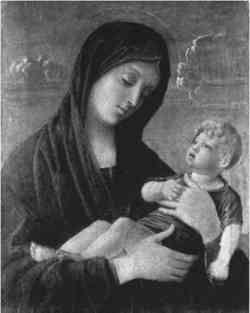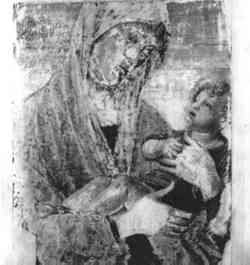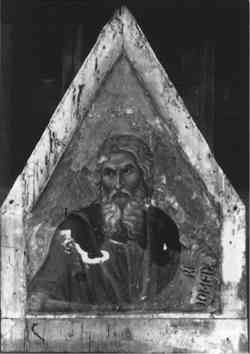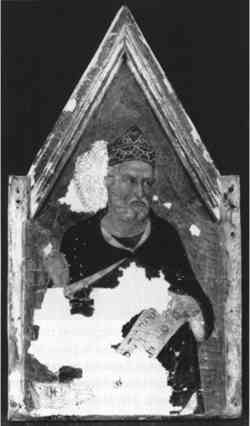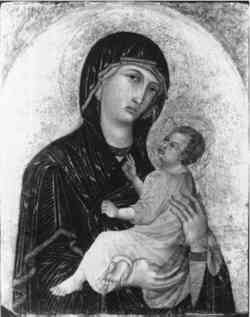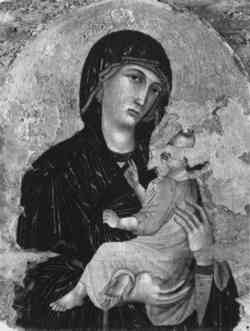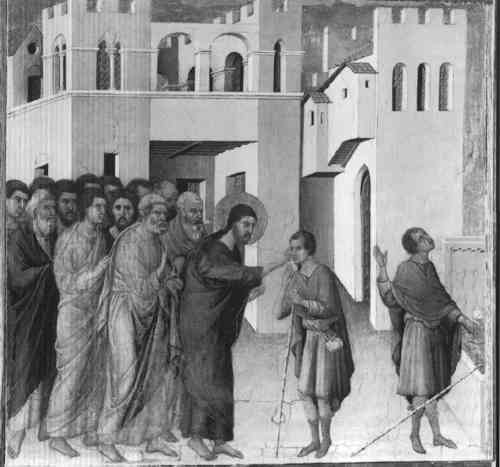THE RESTORATION OF THE EARLY ITALIAN “PRIMITIVES” DURING THE 20TH CENTURY: VALUING ART AND ITS CONSEQUENCESCATHLEEN HOENIGER
ABSTRACT—This article explores the hypothesis that restoration practices are dependent on prevailing tastes by examining the differential status of various periods of Italian Renaissance painting and whether such discrepancies have affected conservation treatment. The hierarchical difference between the early Italian masters and the High Renaissance artists, as articulated most influentially by Vasari, will be associated with contrasting restoration practices. Do the radical cleanings that were carried out on many of the early Italian panels reveal a bias toward paintings by classic artists like Raphael? This article probes the answer to this question by focusing on the label the “primitives,” a complex but inevitably pejorative term used to describe early Italian painters as late as the 1970s. TITRE—La Restauration des Oeuvres “Primitives” Italiennes au Cours du XXE Si�cle: Valorisation de l'Art et ses Cons�quences. R�SUM�—Cet article explore l'hypoth�se selon laquelle les pratiques de restauration sont influenc�es par les go�ts en vogue. Pour cela l'auteur �tudie le statut diff�rentiel accord� aux oeuvres des diverses p�riodes de la Renaissance italienne et les effets que ce statut a sur les traitements de restauration. La diff�rence hi�rarchique entre les premiers ma�tres italiens et les artistes de la Haute Renaissance, ainsi qu'elle est d�finie par Vasari, sera associ�e � des pratiques de restauration tr�s diff�rentes. Le nettoyage radical de certains panneaux italiens peints au d�but de la Renaissance r�v�let-il une pr�f�rence pour les oeuvres d'artistes classiques comme Rapha�l par exemple? L'auteur cherche une r�ponse � cette question en concentrant son attention sur la d�nomination d'oeuvres comme �tant “primitives”, un terme complexe et certainement p�joratif qui d�crit les premiers peintres italiens et qui fut utilis� jusque dans les ann�es 1970. TITULO—La restauraci�n de los “primitivos” italianos durante el siglo XX: La Valoraci�n del Arte y Sus Consecuencias. RESUMEN—Este articulo explora la hip�tesis de que las practicas de restauraci�n son dependientes de los gustos predominantes, examinando el diferente status de varios periodos de pintura del Renacimiento italiano, y si esas discrepancias han afectado los tratamientos de conservaci�n. La diferencia jer�rquica entre los primeros maestros italianos y los artistas del Alto Renacimiento, articulada principalmente por Vasari, se asociar� con practicas opuestas de restauraci�n. Las limpiezas radicales que fueron efectuadas en muchos de los paneles italianos de temprana fecha revelan una preferencia por la pintura de artistas cl�sicos como Rafael? Este articulo investiga la respuesta a esta pregunta concentradose en la denominaci�n “los primitivos”, un termino complejo pero inevitablemente peyorativo usado para describir los primeros pintores italianos, aun hasta la d�cada de 1970. 1 INTRODUCTIONRestoration is sometimes described as revealing an artist's true colors or original intentions, although this is virtually impossible in practice. As David Lowenthal has presented through numerous evocative examples of attempts to preserve—nay, revive—the past, every human intervention on a cultural artifact, no matter how historically motivated, inevitably brings the object into a new state tied to the values of the present (Lowenthal [1985] 1988; Hoeniger 1995; Dykstra 1996). Focusing on the restoration of Italian Renaissance paintings, this article will explore the relationship between treatment 2 THE ART-HISTORICAL VIEW OF EARLY ITALIAN PAINTINGMost of the art-historical literature from the 20th century that addresses Italian Renaissance painting follows a much earlier tradition according little respect to the early schools. Many writers still perpetuate the hierarchical construction of artistic development during the Renaissance that Giorgio Vasari expounded in his Lives of the Artists (1550 and 1568), which was the most influential discussion of the history of Italian Renaissance art (Vasari [1550, 1568] 1878–85). In the three prefaces that frame the chronological sequence of the lives of the great Italian artists, Vasari presented a view of the progressive development of art that appears remarkably biased in hindsight. As Erwin Panofsky explained in an essay of 1930, Vasari reestablished the supremacy of the classical style during the High Renaissance by tracing its emergence from a constructed antithesis: the primitive Gothic past (Panofsky 1930). Vasari outlines a model of artistic progress through quasi-biological cycles of development and renewal. He draws on the idea often expressed by classical historigraphers that the evolution of a state or culture corresponds to the ages of man. There was the cycle of ancient times that reached its peak in the Golden Age of classical Rome, after which art declined and then virtually disappeared during the darkness of the early Middle Ages. But then, as the Renaissance gradually dawned, a second cycle began. According to Vasari, the cycle of the Renaissance developed toward its zenith in three stages or ages, compared metaphorically with infancy and childhood, adolescence, and adulthood or maturity. The first age, or childhood, began with the appearance in the late 13th century in Tuscany of talented artists including Cimabue and, most significantly, Giotto. Vasari describes these childlike artists as eventually “weaned” and brought up beyond the stage of infancy (Vasari [1550, 1568] 1878–85, 2:103). Through increased study of nature, the arts then climbed to a second age, or adolescence, in the 15th century, exemplified by Masaccio and Donatello. Finally, by turning not only to nature but also to the ancients, and by striving not just to equal but to surpass them both, the arts arrived at a second Golden Age during the early 16th century in Florence and Rome. Vasari believed that absolute perfection was embodied in the art of the divine Michelangelo, and to a lesser degree in Leonardo and Raphael (Vasari [1550, 1568] 1878–85, 2:96). This construction of the development of Italian Renaissance art continues to hold sway. It reached us with the help of Heinrich W�lfflin's often-reprinted Die Klassische Kunst or Classic Art of 1899 and 1903, in which Vasari's concept of artistic progress is given fuller stylistic description and also associated with notions of class. For example, W�lfflin ([1899, 1903] 1964, 213) conceives of the transition from 15th-century to High Renaissance painting as a movement from “a bourgeois art” to “an aristocratic one.” Domenico Ghirlandaio's Birth of St. John the Baptist of 1485, in Sta. Maria Novella in Florence, presents fussily detailed settings with many overtly gesturing figures in a manner suited to “middle-class” tastes (W�lfflin [1899, 1903] 1964, 214). By contrast, Andrea del Sarto's Birth of the Virgin of 1514, in the forecourt of SS. Annunziata in Florence, is noble, elevated, dignified, and “aristocratic” (W�lfflin [1899, 1903] 1964, 158). Like Vasari, W�lfflin glorifies the High Renaissance by denigrating that which came before. The early Italian artists of the late 13th and 14th centuries were, accordingly, often seen to be lower class. In fact, Vasari's metaphor of childhood was translated into a conception of these artists as simplistic and, therefore, primitive. As the enduring label i primitivi suggests (Neri Scir� and Valcanover 1985), they were associated with a complex mixture of other “primitive” artists from as yet infantile or uncivilized, typically non-Western cultures (Connelly 1995, 2). In turn, the childlike simplicity seen in their art could be interpreted negatively, as reflecting an ignorance of learned conventions and, therefore, as na�ve and rude, although in some instances the freedom from learned conventions was viewed more positively as unaffectedly truthful and unconsciously expressive (Steegman [1950] 1987). Several decades before W�lfflin's discussion of High Renaissance style, Charles Eastlake ([1857–58, printed 1867] 1988, 121), then director of the National Gallery of London, explained, in this negatively charged way, the inclusion of some very early Tuscan panels as part of a larger purchase of paintings from the Lombardi-Baldi Collection:
Even the members of mid-19th-century purist movements essentially followed Vasari's model, though they assessed the simplicity of the early Italian painters quite positively. Tommaso Minardi, the most active Italian advocate of purism, elevated Giotto's art—believing the Assisi frescoes to be by Giotto—because of the natural simplicity and intensity of expression. He was then compelled to heap even greater praise on the artists of “the period of highest rewards, the period of perfection” (Minardi [1864] 1987, 184). Painters from various centers in Italy, working in the period ca. 1180–1400 or even later, were known collectively as the “primitives” as late as the 1970s; this fact reveals much about prevailing attitudes toward early Italian art. The label “primitive,” with its dual associations of “rude” and “unconsciously natural,” set the early schools apart as different and less polished than “classic” artists. But the implicit contrast was there: these distinctive, rare, and often exquisitely crafted paintings, instead of being appreciated on their own terms, were devalued through a historical comparison with the muscular superrealism of Michelangelo or the robust idealized figures and soft landscapes of Raphael. Vasari's notions of High Renaissance classicism, subsequently elaborated upon in the definition of “fine art” within the French academic tradition, formed the enduring touchstone of artistic perfection against which early Italian painting was measured and was consequently found lacking. Indeed, the post-World War II literature continues the currency of expressions such as “the dawn of Italian painting,” thus perpetuating the belief that these works represent the earliest stages in the artistic evolution that produced the high noon of the High Renaissance. Alistair Smart (1978, 1) chose that image of the dawn for the title of his early Italian survey, first published in 1978, and elaborated on the analogy in his poetic introduction:
Although Smart celebrates what he sees as the distinctly mysterious or otherworldly quality of early Italian painting, the metaphor of the rising sun betrays his acceptance of Vasari's paradigm. This article will propose that such persistent bias in the evaluation of early Italian painting on the part of the art-history and museum communities has, in turn, affected the way these works are preserved for future generations. As I will present in the following pages, the distinctive restoration problems encountered with early Italian paintings have elicited radical, and often unfortunately irreversible, responses. Whether the treatments can be associated with the lower status of the images and the marginalization of their artistic qualities should be considered. The primary problem that faces the restorer of early Italian paintings is the viability of reconstructing badly damaged works. A conservative estimate would indicate that less than 5% of the paintings created during this period have survived (Garrison 1972), and many of those surviving exist in a fragmentary and heavily damaged state. The restorer must, therefore, decide to what extent the effects of the damage should be reduced and, if the losses are to be inpainted, what kind of integration should be attempted. During the 20th century, the most widespread approach has been, first of all, to remove all later fills and repaints in search of what is left of the original. Then, if large losses are discovered, the approach suggests to present the painting with the losses left exposed or with the losses partially integrated using a variety of neutral inpainting techniques (Stout 1941–42). The conservation philosophy that underlies this approach holds that the reconstruction of missing parts cannot be justified if it is hypothetical and also when the loss exceeds a certain size. 3 A TREATMENT BY STEFANO BARDINI IN THE 1870SThe radical cleanings carried out in many 20th-century restorations of early Italian works can be highlighted, initially, through comparison with an example of an aesthetic restoration performed in the late 19th century. The virtually invisible and polished restoration of Simone Martini's St. Catherine of Alexandria (ca. 1322–23), now in the National Gallery of Canada in Ottawa, illustrates how one 19th-century restorer was happy to reconstruct a heavily damaged early panel in a seamless way (figs. 1, 2). The panel was renewed, probably in the 1870s, when it was part of the collection of the Florentine artist and antiquarian Stefano Bardini (Brink 1979–80). Large patches of loss in the saint's proper right hand, the left portion of her mantle, and the tooled halo were recreated using abbreviated simulations of the original techniques and are now barely distinguishable from a normal viewing distance. For the halo, water-based gold-colored paint was brushed into the areas of loss, the lines of the tooling were recut, and red Siena paint was used to imitate the effect of red bole beneath worn gilding. The restoration harmonizes with the original goldwork because the viewer's eye naturally rotates continuously around the circle of the halo, thus allowing for integration (Ruggles 1997).
Bardini seems to have had the painting carefully reworked—or he may have even restored it himself—before the sale to the prince of Liechtenstein, Johannes II (1840–1929); in about 1880. It is difficult to determine whether the polished and complete restoration chosen in this instance relates most specifically to Bardini's training and practice, prevailing restoration philosophy, or the desires of his client the prince of Liechtenstein. All three contingencies may have contributed. Bardini's training was quite typical for restorers during the 19th century. He trained as a painter and expert copyist, learning through the study of historical techniques how to restore works invisibly for the art market. Bardini studied painting at the Accademia di Belle Arti in Florence beginning in 1854. There, under the romantic revival of interest in medieval and Renaissance art, students were encouraged to reproduce past works in their original techniques, either faithfully or in freer modern interpretations, in order to understand the paintings in a purely technical sense. A specific class was also given over to teaching the art students the craft of reproducing or restoring old works of art, whether painting or sculpture (Scalia and De Benedictis 1984). In 1881, when Bardini acquired the Florentine deconsecrated church and convent of San Gregorio, transforming them into his magnificent private gallery, the Palazzo Bardini, he set aside a large studio space that functioned as a laboratory for the restoration and reproduction of works of art. Whether Bardini and his workshop actually produced forgeries to deceive remains unclear. A market certainly existed among the middle classes for reproductions of original works at this time. However, it is somewhat incriminating that Bardini's close friend during the 1870s and early 1880s, the artist and dealer Angiolo Tricci, is strongly suspected of having forged and sold works of art (Scalia and De Benedictis 1984). The restoration treatment carried out under Bardini on Simone's St. Catherine has been described by Alessandro Conti ([1973] 1988, 315) as a “falsification” because of the way extensive damages are concealed. But this evaluation seems rather harsh because invisible inpainting was a widespread practice among late-19th-century restorers and was, indeed, part of their training. Between 1874 and 1922, Bardini amassed a rich collection of Italian paintings, some of which he kept and others of which were offered for sale. Included among these were a significant number of early Italian works, not yet fashionable among collectors. The National Gallery in London, for instance, now owns six Italian paintings datable before 1500 that can be traced back to Bardini's collection in Florence (Davies 1961, 599). Giovanni di Paolo's stunning Coronation of the Virgin, now in the Lehman Collection of the Metropolitan Museum of Art, New York, was in Bardini's collection The prince of Liechtenstein, however, may have had particular tastes when he purchased the Simone in about 1880. One other early Sienese panel discovered by the prince, Naddo Ceccarelli's Christ as the Man of Sorrows, acquired in 1892 from the Ciseri collection in Florence, reveals a taste for the decorative and exquisite craftsmanship characteristic of Simone Martini and his most talented followers (Christiansen et al. 1985). The prince may well have ordered the invisible restoration of Simone's St. Catherine, feeling that the losses inhibited appreciation of the graceful, aristocratic figure by marring the enamel-like finish. 4 TREATMENTS AND ETHICS IN THE 1950s AND 1960sIn contrast, subsequent generations of restorers in Italy, and in North America as well, have typically avoided invisible restorations when paintings by the early Italian masters are concerned. One explanation for this shift from the polished aesthetic restoration carried out by Stefano Bardini in the late 19th century to the nonaesthetic harsh cleanings in the mid-20th century can be found in conservation ethics. No longer trained as painters and copyists, the new professional restorers of the 1950s and 1960s avoided imitative inpainting because they prioritized the recovery and preservation of the original substance of the artist's work. They viewed any additions by restorers as inevitably interpretive, competitive, and falsifying. Cesare Brandi (1906–1988), for years director of the Istituto Centrale del Restauro in Rome, was the key figure in a progressive rethinking of how to compensate pictorial gaps (Brandi 1953, [1963] 1977; Price et al. 1996). Invisible and imitative repainting was rejected either for an extreme purist approach in which losses were left exposed—an approach that Brandi criticized as unaesthetic (Brandi 1963; Sch�dler-Saub 1986)—or for a variety of visible inpainting techniques, including Brandi's rigatino or trateggio (a system of vertical hatchings) and Umberto Baldini's chromatic abstraction and chromatic selection (Baldini 1978–81). Even for Simone Martini and other closely affiliated Sienese artists, whose meticulously crafted gilt and tempera panels would seem to require a perfect finish as part of their presentation, restorers during the 1950s and 1960s often chose not to inpaint. One example is Simone's Madonna and Child from Lucignano d'Arbia (ca. 1320–25) (fig. 3). This unique image of the Madonna holding the swaddled infant Christ to her right side was discovered in 1957 by Enzo Carli benath a 16th-century devotional painting of the Madonna and Child with two small angels during a careful and extended restoration, begun in Siena under Carli but completed, ultimately, by Laura Mora from the Istituto Centrale del Restauro in Rome. Under the supervision of Cesare Brandi, the layers of the 16th-century painting were entirely removed. They found underneath that while the flesh areas of the 14th-century virgin and child had survived intact, almost nothing remained of the original mantle of the Virgin or of the gold background (Carli 1960). These areas of ultramarine and gold leaf had probably been scraped off early on because of their monetary value (Bomford et al. 1990). Carli and Brandi initially decided to leave the large areas of loss evident rather than attempt to reconstruct them through inpainting. Recent art-historical literature celebrates the wondrous discovery of the Simone fragment beneath the
And yet careful examination of postrestoration photographs indicates that, at some point, Carli and his staff at the Soprintendenza in Siena reconsidered the austerity of the late-1950s approach. The initial reproductions, up until at least 1970, show total loss of pigment for virtually the entire mantle of the Virgin (Contini and Gozzoli 1970, plate XII) (see fig. 3). The irregular band of blackish color around her veil, the front opening of the mantle, and the border of her sleeve represent, most likely, the remains of a green, verdigris lining. By 1980, however, the area of the blue mantle has been toned in subtly with a gray-blue field of color to mediate the viewer's reception of the painting by evoking the contours of the virgin's head and shoulders (fig. 4). Such rethinkings are typical of the 1970s and 1980s, a subject to be explored later in this article.
In North America, the extreme purist approach to the preservation of early Italian panels can be seen most obviously at the Yale University Art Gallery in New Haven, home to an extensive number of early pictures collected primarily by the 19th-century cultural educator James Jackson Jarves. Between 1950 and 1971, the Yale gallery curator Charles Seymour mounted and supervised a restoration campaign under the influence of current purist restorations in Italy. Seymour got advice from Ugo Procacci, founder of the department of Proudly exhibited and cataloged in 1972 with before photographs to facilitate an appreciation of the recent restoration work, the Yale pictures were touted by Seymour as “authentic” representatives of the styles and techniques of the early masters. According to the style-criticism approach of current art history, once freed from all “accretions,” the intrinsic qualities inherent in each painting—qualities adhering only to the original—might be admired by someone conversant with artistic characteristics and developments. Indeed, the radical cleaning was justified as a means of recapturing the spirit of the original masters: “Were … Jarves still alive today, he might well have followed sympathetically the efforts of the 20th century to make clearer the quality of the originals by removing repaints and to re-establish their authenticity by recognizing a fragment honestly as a fragment” (Seymour et al. 1972, 5). Furthermore, by the 1950s, the gallery staff at Yale held Jarves's favorite restorer, Giorgio Mignaty, responsible for dulling the colors and textures of the paintings, thus distancing the contemporary viewer from a true appreciation of the originals. Seymour, therefore, wanted the pictures to be cleaned and rehung in a way he considered honest and current. In line with prevailing trends in paintings conservation, all previous restoration work was removed from the panels. No new retouching was contributed so as to recover as much as possible of the originals The tiny tempera on panel, Christ on the Cross, attributed to the workshop of Filippino Lippi in about 1495, had been repainted in oils in the 19th century, presumably by Mignaty at the request of Jarves (fig. 5). During the cleaning of 1961–62, all additions considered nonoriginal were removed, leaving very little, save the preparatory gesso ground and the under-drawing in a charcoal wash (fig. 6). The ruinous condition of the miniature panel, though supposedly authentic, is disturbing. Designed originally as a private devotional image to spur its owners' deep contemplation of Christ's sacrificial suffering during His life on earth, the radical stripping of paint from the image, including the flesh paint from the figure of Christ, seems insensitive and na�ve. The narrow-minded search for what remains of the original appearance of the painting has led to a violation of its original religious meaning.
Another devotional panel, a small Venetian Madonna and Child (ca. 1475–85), has suffered the same fate and has also now been relegated to storage (figs. 7, 8). Its value has actually fallen as a result of the cleaning; it had been attributed to Giovanni Bellini himself, now workshop. In this case, the post facto rationalization is particularly revealing. As a fragment, the catalog explains, the work's interest is primarily “historical” and “cultural,” and, as a result, a portion of the early-20th-century restoration has been left (Seymour et al. 1972, 53). The bias is evident in the limited sense in which “historical” and “cultural” are understood. Clearly, there is little sympathy for the original cultural function that the image was designed to fulfill. In the Renaissance, a valued devotional image would never have been allowed to deteriorate to such an extent; to strip a religious painting would have been sacrilege. Contemporary worshipers and artists realized that it was essential to show the Virgin respect
In contrast to the purist restoration approach adopted for early Italian panels in the Yale Collection, a High Renaissance painting presented by Jarves in 1871, the Circumcision attributed to Titian in his early period (ca. 1510), was treated with more aesthetic sensitivity. In the cleaning of 1968, heavy repainting was removed to reveal uneven damage, including areas where only the initial sketchy paint layer remained. In this instance the losses were partially inpainted by Petryn. The catalog entry may provide hints as to why some compensation was desirable. The “splendid color and impasto” of the picture are described with evident appreciation and the viewer is reassured that the “main lines of the composition” and the “basic color scheme” are not broken by the losses (Seymour et al. 1972, 32–33). A more aesthetic restoration approach seems to have been chosen to preserve the coloristic richness and tonal transitions for which 16th-century Venetian art is famous. 5 RETHINKING AND COMPROMISE IN THE 1970s AND 1980sIn more recent decades, restorers have begun to re-evaluate the exclusive desire for so-called honesty reflected in the post-World War II cleanings just discussed. Indeed, some treatments carried out at the National Gallery in London reveal attempts to reach compromises Movement toward compromise can be seen in the restoration of fragments from Ugolino di Nerio's Sta. Croce Polyptych, for example. Several heavily damaged portions from this Sienese altrapiece of about 1324–25 were partially reconstructed in two separate campaigns during the early 1970s and the mid-1980s. The pinnacle panel of Isaiah, cleaned in 1970, demonstrates how extensive, disfiguring paint losses, particularly evident in the drapery, were inpainted using matching neutral fields of color but without redrawing the inscriptions, the modeling of the drapery, or the lost portions of Isaiah's hands (figs. 9, 10). When the David panel from the same altarpiece was restored between 1983 and 1984, however, more liberty was taken to recreate the spirit of the original by redrawing compositional outlines in a general way, and reconstructing the losses to the gilded background, including the ornamentation of the halo in an abbreviated form (figs. 11, 12). The intention of the 1983–1984 restoration, as Anthony Reeve has remarked, was “to reduce but not to disguise the distracting effects of the damage” (Gordon and Reeve 1984, 51). Inpainting was carried out using matching neutral fields of color, but the restorers were careful to preserve the distinction
6 A SUGGESTIVE COMPARISONEvidently, the restorations of many early Italian paintings performed during this century reflect a general consensus that the effects of damage should not be fully disguised. Although restorers have differed in the degree to which they believe distracting losses should be reduced, deceptive inpainting techniques are rarely used. Whereas, to this day, damaged paintings by important High Renaissance artists, such as Raphael and Andrea del Sarto, are treated as aesthetic entities and their losses disguised to preserve artistic coherence, early Italian works have been consciously left in their damaged condition. A comparison of two panels restored recently at the Louvre illustrates this discrepancy. Raphael's Angel, a fragment from the large St. Nicholas of Tolentino Altarpiece painted by the young artist in 1500–1501, was meticulously inpainted in 1983 to conceal a large triangular system of losses down the center of the angel's face. The Louvre restorers felt that the central losses, which they described as cutting the angel's face in two, destroyed the visual appreciation of the painting. After considering various options, they decided to adopt a pointillist inpainting technique, harmonious with the oil technique of Raphael's original, to integrate the losses in a manner discernible on close scrutiny. In practice, however, the angel's face appears fully integrated, with the exception of the lack of craquelure, even in the detailed color reproductions that accompany the publication of the restoration (Bergeon 1990). The approach at the Louvre to an early Italian painting is in stark contrast. The extensive losses around the edges of Fra Angelico's Angel of the Annunciation, originally part of a ciborium designed in the 1420s for San Domenico in Fiesole, were left fully exposed, right down to the wood support. Because the largest and most evident areas of loss, in this case, were peripheral, the Louvre restorers argued that it seemed advisable to resist reintegration and to leave the bare wood exposed and the gold leaf full of lacunae. Even in this fragmentary condition, they contended, one could still fully appreciate the vivid colors and precise technique of Fra Angelico. Furthermore, the well-used condition, they suggested, was compatible with the age of the work (Bergeon 1990). The Louvre restorers further contended that the damage to the Raphael was more disfiguring, because of its central location, than the peripheral losses in the Fra Angelico. Many might find this explanation extremely reasonable. However, when set in the context of more widespread trends in the treatment of the early masters as compared with High Renaissance works, the Louvre restorers' rationalization gives pause for thought. Restorers do not simply work on a case-by-case basis, making objective judgments respectful of each individual painting. In the spirit of suggestion rather than proof, therefore, I would like to place in association with the Louvre Raphael, an earlier panel with a large central loss but from a quite different museum context. The Madonna and Child no. 593 in the Pinacoteca Nazionale of Siena, attributed to the Master of Badia a Isola, an artist close to the young Duccio, sustained a disturbing loss through the face of the Christ Child. The loss remained hidden up until 1978, having been repainted in oils prior to the acquisition of the work in 1906, and then again following the cleaning of 1932 (Stubblebine 1979). However, in 1978, the integrating additions were removed and the distressing lacuna has remained exposed to this day (figs. 13, 14). This evidence from another gallery suggests that similar central losses, when they occur on early panels, are sometimes left exposed. Early panels are often allowed to reveal their imperfect condition, a condition deemed appropriate to their age. High Renaissance paintings (some-times even those in the same institutions) are treated quite differently.
7 UNDERLYING IDEOLOGIESI would like to go further and suggest that such overt presentations of aged and damaged panel paintings may reflect biases similar to those of Against this reading, some might counter that the archaeological approach was held in high esteem during the 1950s through the 1970s because of its association with the preservation of cultural heritage in its rich diversity. Nevertheless, when the archaeologically pure restorations of the “primitives” are set in conjunction with the much more aesthetic treatments of works by Raphael and Titian, it becomes apparent that the artistic qualities of the early masters have not been valued highly. The early panels are allowed to show their age and wear, whereas a supposedly more refined High Renaissance painting is made to appear timeless. Indeed, it could be argued that early Italian paintings share two characteristics with the bulk of non-Western images that link these otherwise diverse cultural products unconsciously in the minds of traditional art historians and the conservators who work alongside them. Both types of images are held to be largely outside the Western canonical notion of art making, which is based on humanist concepts of that which constitutes fine art. This notion proposes Yet, in the last 15 years, historical conscience together with the rise of postcolonial theory and the institutionalization of cultural sensitivity have helped create an intellectual environment in museums in which sacred and social objects are understood in the spirit in which they were created, and sometimes preserved Increasing awareness of the contextual dimensions of early sacred art appears to be having an impact, in turn, on conservation practices. The change is well illustrated by the restoration in 1983 at London's National Gallery of the predella scene, Jesus Opens the Eyes of a Man Born Blind, from Duccio's Maest� altarpiece of 1308–11 (fig. 15). There was unfortunate paint loss to the cured man's face in the focus of narrative interest: the man's open eyes are the evidence of Christ's miracle. The painting was sensitively reconstructed by the London restorers, who deliberately resisted imitating the craquelure of the original paint layers to enable a careful observer to identify the inpainting (Bomford et al. 1990). As David Bomford explained, in this instance a virtually deceptive inpainting technique was “essential” to preserve the narrative message (Bomford et al. 1990, 51). One does have to recognize that Duccio's Maest� is one of the most seriously studied and fully appreciated early Italian works (White 1979, 80) and that it may take more time and imagination for the messages and aesthetics of less famous early images to be similarly respected. Nevertheless, there is substantive evidence that approaches are beginning to shift. In certain instances, as David Bomford explained with Duccio's miracle scene in mind, the conscientious desire to present a fragmentary painting “honestly” has been suppressed, and preserving the message of the religious narrative is prioritized instead.
8 CONCLUSIONSThis article has explored the relationship between the restoration treatments of several early Italian panel paintings during the 20th century and the status of this group of images in art-historical writings. Termed “primitive” until very recently, paintings from the early schools carry a history of negative evaluation even today. I have suggested that such values affect restoration approaches and, more specifically, underlie the purist radical cleanings of the 1950s and 1960s in Italy and at Yale. In turn, I have proposed that more recent restorations of the 1970s and 1980s, which attempt to preserve the aesthetic or narrative aspects of these early images, reveal the same kind of rethinking that is evident, concurrently, in the art-historical literature. Through case studies from early Italian painting, this article explores how restoration can be interpreted in relation to reception and taste and how treatment approaches can be intimately connected to the valuation of the object, revealed in the way the painting is written about and exhibited (Phillips 1997). ACKNOWLEDGEMENTSAn earlier version of this paper was presented in February 1997 at the College Art Association in New York, in a session on conservation in cultural context co-organized by Stephen Mellor and Rebecca A. Rushfield. My research was generously funded by the Social Sciences and Humanities Research Council of Canada. First and foremost, I would like to thank Norman Muller for his continuing encouragement and enthusiasm. For assistance during the research stages, I would like to thank Mark Aronson, head of conservation, Yale University Art Gallery. I have also benefited greatly from the helpful anonymous reviews. My colleague NOTES. It is important to mention that The Yale University Art Museum is currently engaged in a collaborative project with the J. Paul Getty Museum to rehabilitate as many of the early Italian paintings at Yale as possible. This exciting project was initiated by the Yale conservators Mark Aronson, Patricia Garland, Joachim Pissarro and Joanna Weber, who are carrying out the new treatments at the Getty in conjunction with the Getty conservators Gene Karraker, Mark Leonard, Elisabeth Mention, Andrea Rothe, and Yvonne Szafran. Carl Brandon Strehlke of the Philadelphia Museum of Art is providing advice on which paintings should be prioritized. The dramatic results of this project are already visible in the galleries at Yale. REFERENCESBaldini, U.1978–81. Teoria del restauro e unit� di metodologia. 2 vols. Florence: Nardini. 1:186. Baxandall, M.1972. Painting and experience in fifteenth century Italy: A primer in the social history of pictorial style. Oxford: Oxford University Press. Belting, H.1994. Likeness and presence: A history of the image before the era of art. Trans. E. Jephcott. Chicago: University of Chicago Press. 459. Bergeon, S.1990. Science et patience ou la restauration des peintures. Paris: Editions de la R�union des mus�es nationaux. 230–31, 254. Bomford, D., et al. 1990. Art in the making: Italian painting before 1400. London: National Gallery Publications. 50, 51, 89. Brandi, C.1953. Il restauro dell'opera d'arte secondo l'istanza estetica o dell'artistic�. Bollettino dell'Istituto Centrale del Restauro13:1–8. Brandi, C.1963. Il trattamento delle lacune e la Gestalt psycologie. In Problems of the 19th and 20th centuries: Studies in Western art, vol. 4. Princeton, N.J.: Princeton University Press. 146–51. Brandi, C.. [1963] 1977. Teoria del Restauro. Torino: Einaudi. Brink, J.1979–80. Simone Martini's St. Catherine of Alexandria: An Orvietan altarpiece and the mystical theology of St. Bonaventure. National Gallery of Canada, Annual Bulletin3:37–56. Carli, E.1960. Ein Neuer Simone Martini. Pantheon18:165–71. Chelazzi Dini, G.1985. In Simone Martini e “chompagni.”Florence: Centro Di. Christiansen, K., et al. 1985. Liechtenstein: The princely collections. New York: Metropolitan Museum of Art. 189–91. Cole, B.1976. Giotto and Florentine painting, 1280–1375. New York: Harper & Row. 98. Connelly, F. S.1995. The sleep of reason: Primitivism in modern European art and aesthetics, 1725–1907. University Park, Pa.: Pennsylvania State University Press. 2–22. Conti, A. [1973] 1988. Storia del restauro e della conservazione delle opere d'arte. Milan: Electa. Contini, G., and M. C.Gozzoli. 1970. L'opera completa di Simone Martini. Milan: Rizzoli Editore. Corrie, R. W.1990. The political meaning of Coppo di Marcovaldo's Madonna and Child in Siena. Gesta29:61–75.
Davies, M.1961. The early Italian schools: National Gallery catalogues. 2d ed.London: National Gallery Publications. deCastris, P. L.1989. Simone Martini: Catalogo completo dei dipinti. Florence: Cantini Editore. 86. Dykstra, S. W.1996. The artist's intentions and the intentional fallacy in fine arts conservation. Journal of the American Institute for Conservation35:197–218. Eastlake, C. [1857–58, printed 1867] 1988. Report of the director of the National Gallery. In M.Davies, The early Italian schools before 1400, rev. D. Gordon. London: National Gallery Publications. App. 1. Elkins, J.1995. Art history and images that are not art. Art Bulletin77:553–71. Fabbri, N. R., and N.Rutenburg. 1981. The tabernacle of Orsanmichele in context. Art Bulletin63:385–405. Garrison, E. B.1972. Note on the survival of 13th-century panel paintings in Italy. Art Bulletin54:140. Gombrich, E. [1966] 1971. Norm and form: The stylistic categories of art history and their origins in Renaissance ideals. In Norm and form: Studies in the art of the Renaissance. 2d ed.London and New York: Phaidon. 81–98. Gordon, D., and A.Reeve. 1984. Three newly-acquired panels from the altarpiece for Santa Croce by Ugolino di Nerio. National Gallery Technical Bulletin8:36–52. Hendy, P.1931. The Isabella Stewart Gardner Museum: Catalogue of the exhibited paintings and drawings. Boston: Isabella Stewart Gardner Museum. 240. Hoeniger, C.1995. The renovation of paintings in Tuscany, 1250–1500. Cambridge and New York: Cambridge University Press. 21–42, 151, 156. Lowenthal, D. [1985] 1988. The past is a foreign country. Cambridge: Cambridge University Press. Minardi, T. [1864] 1987. Tommaso Minardi sulla qualit� essenziali della pittura italiana dal suo risorgimento fino alla sua decadenza, extracted in19th-century theories of art, ed. and trans. J. C. Taylor. Berkeley: University of California Press. 176–94. Neri Scir�, G., and F.Valcanover. 1985. Gallerie dell' Accademia di Venezia. Milan: Electa. 196. Panofsky, E.1930. Das erste Blatt aus dem 'Libro' Giorgio Vasaris: Eine Studie �ber der Beurteilung der Gotik in der italienischen Renaissance mit einem Exkurs �ber zwei Fassadenprojekte Domenico Beccafumis. St�del-Jahrbuch6:25–72. Phillips, D.1997. Exhibiting authenticity. Manchester and New York: Manchester University Press. 126–96. Pope-Hennessy, J., with L. B.Kanter. 1987. The Robert Lehman Collection. New York: Metropolitan Museum of Art; Princeton, N.J.: Princeton University Press. 120. Price, N. S., M. K.TalleyJr., and A. M.Vaccaro, eds.1996. Historical and philosophical issues in the conservation of cultural heritage. Los Angeles: Getty Conservation Institute. Ruggles, A.1997. Personal communication. Painting Conservation, National Gallery of Canada, 380 Sussex Dr., Ottawa, Ontario K1N 9N4, Canada. Scalia, F., and C.DeBenedictis. 1984. Il Museo Bardini a Firenze. 2 vols. Milan: Electa. 1:8, 13. Sch�dler-Saub, U.1986. Theorie und Praxis der Restaurierung in Italien: Zur Entwicklung der Gem�lderetusche von der Renaissance bis zur Gegenwart. Maltechnik-Restauro92:25–41.
Seymour, C., Jr.1970. Early Italian paintings in the Yale University Art Gallery. New Haven, Conn.: Yale University Press. 7. Seymour, C., Jr., et al. 1972. Italian primitives: The case history of a collection and its conservation. New Haven, Conn.: Yale University Art Gallery. Smart, A.1978. The dawn of Italian painting, 1250–1400. Oxford: Oxford University Press; Ithaca, N.Y.: Cornell University Press. Steegman, J. [1950] 1987. Consort of taste, reissued as Victorian taste: A study of the arts and architecture from 1830 to 1870. London: Century. 61–74, 250–51. Stout, G. L.1941–42. Treatment of blemished paintings. Technical Studies in the Field of the Fine Arts10:99–112. Stubblebine, J. H.1979. Duccio di Buoninsegna and his school. 2 vols. Princeton, N.J.: Princeton University Press. 1:78. vanMarle, R.1920. Simone Martini et les peintres de son �cole. Strasbourg: Heitz. vanOs, H.1984. Sienese Altarpieces, 1215–1460, vol. 1. Groningen: Bouma's Boekhuis. Vasari, G. [1550, 1568] 1878–85. Le vite de' pi� eccellenti pittori scultori ed architettori. Ed.G.Milanesi. 9 vols. Florence: G. C. Sansoni. White, J.1979. Duccio: Tuscan art and the medieval workshop. London: Thames and Hudson. W�lfflin, H. [1899, 1903] 1964. Classic art: An introduction to the Italian Renaissance. Trans. P. and L. Murray. 8th ed.London: Phaidon Press. 231–50. Wood, J.1991. Perceptions of holiness in 13th-century Italian painting: Clare of Assisi. Art History14:301–28. AUTHOR INFORMATIONCATHLEEN HOENIGER is associate professor of art history at Queen's University in Canada, where she teaches Italian medieval and Renaissance art as well as the crossover area between art history and art conservation. She has an M.A. in the history of science from the University of Toronto in 1983 and a Ph.D. in art history from Princeton University in 1989. Her dissertation is on the painting technique of Simone Martini, and she has published on this subject in Gesta and JAIC. She has also written on luxury silks in Venetian Trecento paintings for Electa, and on the techniques and conservation of wall paintings for The Dictionary of Art. Her book, The Renovation of Paintings in Tuscany, 1250–1500, examines the reworkings to a number of important early Italian paintings in relation to devotional and civic practices and questions the modern tendency to remove such “accretions” in search of the original. She is currently working on a broader study of art restoration and taste. Address: Queen's University, Department of Art, Kingston, Ontario, K7L 3N6, Canada.
 Section Index Section Index |

